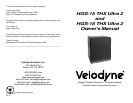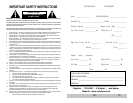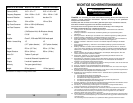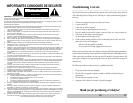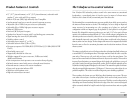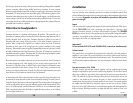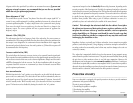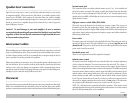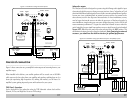
External remote jack
This connection allows an auxiliary infrared remote receiver "eye" to be installed and
placed where most convenient. This option is usually only required when the subwoofer
is to be part of a custom installation in which the built in "eye" (located adjacent to the
speaker on the front baffle) will be hidden in a location where it can not adequately receive
signals from the remote.
High pass crossover switch- 80Hz (THX)/100Hz
This switch selects the frequency for the high pass crossover outputs. This crossover is
functional on both line and speaker-level outputs. Smaller speakers with limited low
frequency ability may prefer the higher 100Hz setting which will reduce the low frequencies
sent to them. Larger speakers with greater low frequency output may be able to handle the
80Hz setting without strain.
Power switch
The master power switch is located on the right half of the unit. This rocker style switch is
the main on/off for the unit. This switch should be set to position 1 (up) for on, and 0
(down) for off. If the unit is to be left unused for an extended period of time, the master
power switch should be turned off.
Detachable power cord
Allows for easy replacement should the original be damaged.
Infrared remote control
The remote control unit supplied with your subwoofer allows for convenient adjustment
of select subwoofer functions. The power button turns the unit on/off. The volume +/-
buttons on the remote allow you to increase or decrease the output volume of the unit
relative to the setting of the main volume control on the rear panel. The middle reset button
returns the remote volume control to neutral, output level will then be determined by the
manual volume control setting. Initial setup of the unit should be performed with the
remote volume at neutral, while you adjust the manual volume knob to match playback
levels. The mute button silences the unit. If you choose to utilize the remote to turn the
unit on/off, we suggest setting the auto turn on switch to the on position. This deactivates
the sensing circuitry allowing the remote to have total control of unit power.
NOTE: Two AAA batteries are required & included for operation. If the remote control
operating range deteriorates, please check batteries for deterioration. Do not leave remote
placed on heat generating items, such as amplifiers.
5
☞
8
Speaker-level connection
––––––––––––––––––––––––––––––––––––––––––––––––––––––––––––
Figure 2 shows an easy way to connect your Velodyne subwoofer directly to your receiver
or integrated amplifier. When connected in this fashion, your satellite speakers will be
crossed over at 80/100Hz, which removes the lower bass from your speakers, enabling
them to do a better job reproducing high frequencies. You may also connect your satellites
directly to your receiver or amplifier along with the subwoofer if you wish to bypass the
internal high-pass crossover.
Caution!!! To avoid damage to your main amplifier, be sure to maintain
correct polarity when making all connections. Red (positive) to red, and black
(negative) to black. Be sure that all connections are tight, and that there are
no loose strands or frayed wires.
Interconnect cables
––––––––––––––––––––––––––––––––––––––––––––––––––––––––––––
When installing your new Velodyne subwoofer using the line level connections, you should
always use shielded phono cables. There are many decent cables available today, most any
of which will work perfectly well. We do recommend that you keep the length of cable as
short as possible to avoid any potential noise problems.
When using speaker level connections, use a decent quality speaker cable that mates well
with the connectors. Be very careful to avoid any loose strands or frayed wires which may
result in a short, which may damage your equipment. Cables of extremely large size are
typically not required. Extremely large gauge wire may not properly fit in the binding posts,
resulting in a poor connection and possible short circuits.
Placement
––––––––––––––––––––––––––––––––––––––––––––––––––––––––––––
True subwoofers operate at extremely low frequencies which are primarily non-directional.
While it is recommended that the subwoofer be placed on the same plane as the satellite
speakers, room and system conditions often dictate otherwise. Keep in mind that frequency
☞
continued. . .



